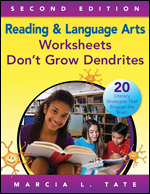Reading and Language Arts Worksheets Don't Grow Dendrites
20 Literacy Strategies That Engage the Brain
- Marcia L. Tate - Developing Minds, Inc.
Brain-Friendly Teaching & Learning | Literacy, K-12 | Teaching Methods & Learning Styles
Brain-based strategies turn reluctant readers into motivated and engaged learners!
Experts say that when students engage in learning, comprehension is more likely to occur. Building on Marcia Tate’s 20 successful “dendrite-growing” teaching strategies, Reading and Language Arts Worksheets Don’t Grow Dendrites, based on the very latest research, contains more than 200 activities for delivering brain-based literacy instruction.
Now in a new, reader-friendly format and consistent with the Common Core State Standards, this classroom companion is dedicated to improving the way students learn to read and read to learn. You’ll discover hands-on techniques grouped by grade level and standard to help teach reading in relevant ways. Activities cover essential categories of literacy and language arts instruction, including
- Phonemic and phonological awareness
- Fluency and vocabulary instruction
- Text comprehension
- Writing
- Speaking and listening
- Language
- Cross-curricular instruction
- Reading literacture and information text
When teachers understand how to plan and execute great lessons and when students are involved and engaged, true learning occurs. Start today!
Praise for the previous edition:
“I thoroughly enjoyed reading this user-friendly book and plan to share the activities with teachers working with struggling readers.”
—Catherine Duffy, English Chairperson
Three Village Central School District, East Setauket, NY
